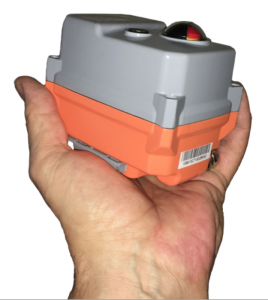WHAT IS AN ELECTRIC ACTUATOR?
An electric actuator or to be more precise an electric valve actuator, is a machine that converts electrical energy into rotary torque which is used to drive a valve.
Typically an electrical actuator consists of an electric motor or motors, which produce low torque at high speed. Connected to a gearbox, the speed is slowed and as it does, the torque increases. At the electric actuator’s output drive, the final low speed produces high torque so that the required rotary torque is available at an acceptable speed. Electrical circuits or electronic circuitry is used to control the starting and stopping of the motor when the valve is at the required position.
HOW DOES AN ELECTRIC ACTUATOR WORK?
There are two main methods of achieving an electric opening and closing of a valve, one relates to a quarter-turn valve only, the other to either a part-turn or multi-turn electric actuator.
Generally only applicable with an electric ball valve, is a uni-directional electric valve actuator.
A uni-directional electric actuator always rotates in the same direction with the motor being stopped at 90 degree intervals, typically by cams fixed to the output shaft striking electrical micro-switches which cut the power to the motor, and await an electrical command to run to the next position. This type of electrical actuator function reduces the cost of the electronic controls as the motor always rotates in the same direction.
Despite this uni-directional electric actuators are not a popular design as they are now out-dated and are now relatively rare. By far the most common type of electric actuator is the reversible electric valve actuator. This type of actuator drives a valve from open to close in one direction – usually clockwise, then reverses to travel from the closed to the open position. The direction of rotation of the motor reverses to achieve this operation. In on-off reversible electric valve actuators the motor runs and via the gearbox to which it is connected, rotates the output drive until either cams fixed to the output shaft strike electric micro-switches, or alternatively magnetic sensors, detect the desired position and stop the motor. The motor awaits the next electrical command, at which point the motor runs in the opposite direction to reverse the output shaft, again until either cams or magnetic sensors stop it.
WHAT DIFFERENT SIZES OF ELECTRIC ACTUATORS ARE AVAILABLE?
Electric valve actuators are available from very small sizes to operate small bore low torque ball valves typically used in light duty domestic applications, to actuators capable of working in aggressive and explosive atmospheres and using complex gearing to enable them to operate large diameter valves at very high pressures. The actuators themselves differ enormously as a light duty domestic electric actuator may have a mainly plastic construction whereas the actuators suitable for explosive atmospheres can be constructed from steel or even stainless steel. Internally too, the materials and quality of the gears, electric motors and motor controls will reflect the difference in loads that they will endure.

SOME STANDARD FUNCTION OPTIONS
ON-OFF CONTROL
The most common application where the electric actuator is powered open and powered closed, and the actuator runs from fully open to fully closed in a continuous movement, and vice versa.
FAILSAFE FUNCTION
A rechargeable battery or an internal capacitor is kept charged and provides the power to send the failsafe actuator to its pre-set failsafe position on the loss of external power. Another way that eliminates any alternate electrical source is by using a mechanical spring which is tensioned by the motor when power is available and released when power fails.
MODULATING CONTROL
Modulating or proportional control is achieved by using a form of positioning.
The positioner creates modulating control where opening angle of the electric actuator is set proportionally to the input control signal. Control signals are typically either 0-10V or 4-20mA so in a 4-20mA system a 4mA signal would close the actuator, 12mA would set it 50% open and 20mA would set the actuator in the fully open position. Positioners work by comparing the input control signal with the physical position of the output shaft, proportionally, and if a difference exists, automatically runs the actuator’s motor in the direction needed to correct the difference.
Electric actuators with proportional control are used to regulate valves as opposed to an on-off actuator which simply isolates flow.



